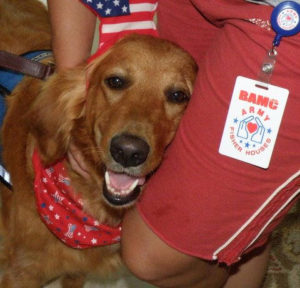By Carol Spicer
The Clifton Record
 Lisa Williams, a dog trainer for the Train a Dog, Save a Warrior program has visited with David Sager at the local Bosque Animal Rescue Kennels prior to her visit on Tuesday, when she came to pick up the two dogs going into the program.
Lisa Williams, a dog trainer for the Train a Dog, Save a Warrior program has visited with David Sager at the local Bosque Animal Rescue Kennels prior to her visit on Tuesday, when she came to pick up the two dogs going into the program.
Williams had picked out Lindy and Holly when BARK offered the donation of dogs to the program, and already knows a veteran who may receive one of the two dogs – after specialized training.
Williams explained that the dogs will first be basically trained by her in specific commands for specific needs, then both the veterans and the dogs are trained together, prior to any permanent home being located for each dog.
“We make sure that the veteran and the dog are a perfect match for each other, and that both are fully trained prior to any permanent situation,” said Williams. She noted that usually the program works with dogs that are at least a year old and train them fully for different uses.
The program information gives the following as to how TADSAW STSD service dogs can help: “A rescue dog from a shelter or the warrior’s own personal dog, if deemed appropriate in temperament, demeanor, and size, will be evaluated, enter Boot camp, and be trained specific commands for specific needs of a wounded warrior with PTSD.
Once trained, these dogs have the ability to decrease isolation of the veteran, decrease the needs for many medications, decrease anxiety and panic attacks when in crowded public places, awaken them from nightmares and flashbacks, ‘have their backs’ when necessary, to name but a few. The result is a positive, non judgmental, unconditional relationship desperately needed by both. These dogs can quite literally become a serviceman’s or servicewoman’s best friend.
A short answer as to the why and how is that petting a dog decreases release of cortisol and increases release of oxytocin into the bloodstream. Decreases in cortisol lower blood pressure and facilitate a sense of relaxation, while increases in oxytocin, this same chemical released when a mother nurses her infant, will facilitate a sense of security and well-being.
For warriors with PTSD, it has been documented that a dog helps with emotional regulation. Patients who are very anxious and have anger issues find they can’t work with a dog if they yell. They must have a calm voice. Working with a dog helps build confidence and bridge the gap with strangers. More often than not the response and the bond is immediate.
TADSAW has found that a great majority of the warriors with PTSD choose a shelter dog because they want ‘to save something’. They may choose a dog with an injury because they have an injury too. They are both healing. They fit together. They are a team.
This extensive and costly training is at no charge to the warrior and his dog, with training lasting 3-4 months at the least. Once training is completed and the American Kennel Club’s Canine Good Citizenship classification is awarded to the team, and after intensive training to meet the specific needs of the specific warrior, the dog will be eligible for service dog designation, according to the American Disabilities Act.
The team will carry the necessary health certificates and documentation and will be able to accompany the warrior to stores, restaurants, living accommodations, and permitting full access to any and all places the warrior wishes to visit.
“For hundreds of wounded veterans, the long walk to recovery is often a lonely one. A long walk is something most dogs love,” said a TADSAW spokesman.
“We are very proud to be able to find a couple of dogs in BARK that are able to be donated, trained and used in the veterans’ program,” said BARK President Nancy Benda.